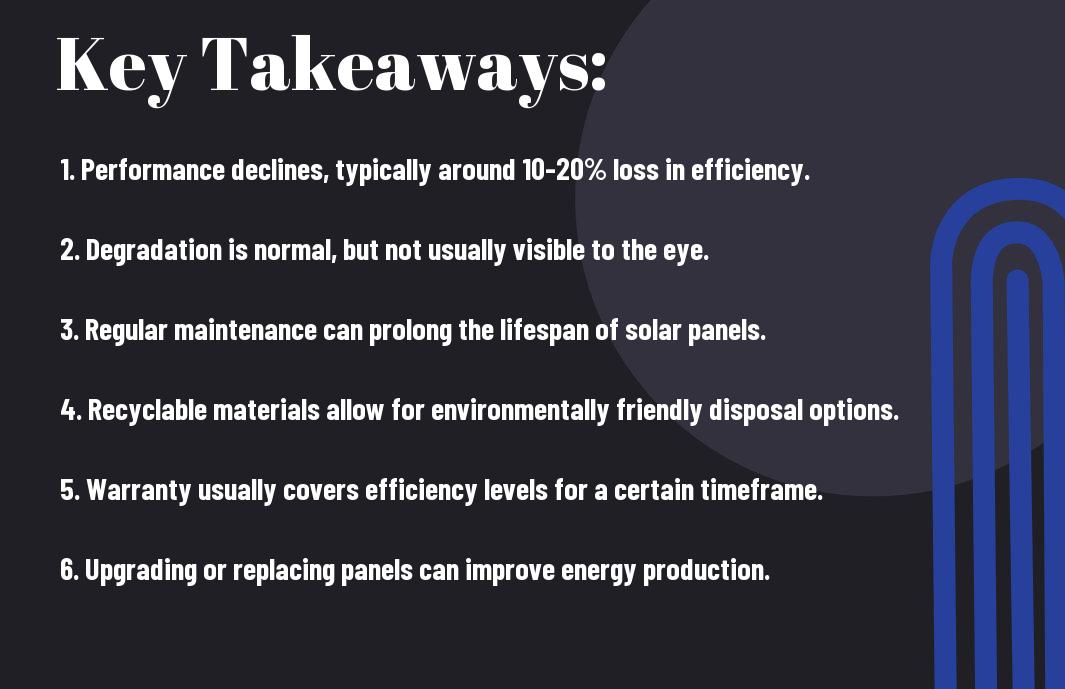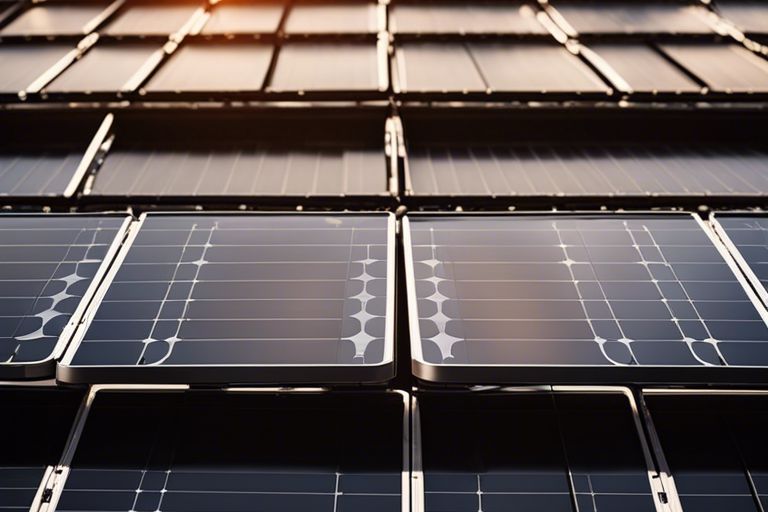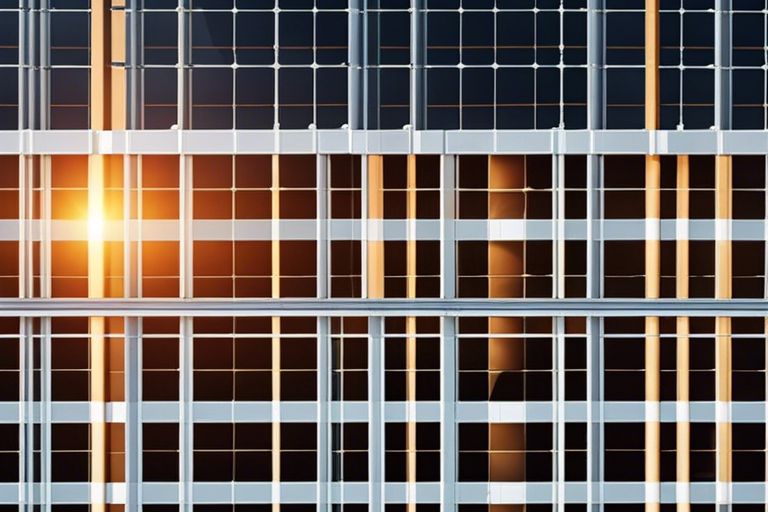Deterioration is a natural process that affects everything, including solar panels. After a decade of harnessing the sun’s energy, your solar panels may show signs of wear and tear that can impact their performance. In this article, we will explore what happens to solar panels after 10 years, how it can affect their efficiency, and what steps you can take to maintain their longevity and effectiveness.
Key Takeaways:
- Degradation: Solar panels typically experience a slight decrease in efficiency over 10 years due to degradation.
- Warranty: Many solar panel manufacturers offer warranties that guarantee a certain level of performance after 10 years. Check your warranty to see if you’re eligible for any replacements or repairs.
- Recycling: At the end of their lifespan, solar panels can be recycled to recover valuable materials and components, minimizing environmental impact.


The Warranty Period
The What Happens to Solar Panels When They Die is an important aspect to consider when investing in solar panels. When you purchase solar panels, they come with a warranty to protect you in case of any issues that may arise. Let’s look into what typically happens during the warranty period for solar panels.
Typical warranty terms for solar panels
For most solar panel manufacturers, the typical warranty terms cover around 25 years. This means that during this period, the manufacturer guarantees a certain level of performance from your solar panels. However, it’s imperative to check the warranty details for each specific brand as the terms may vary.
What is covered during the warranty period
During the warranty period, most manufacturers offer coverage for any defects in materials or workmanship that may affect the performance of your solar panels. This means that if your panels are not producing as much energy as they should due to these issues, the manufacturer will repair or replace the panels for you.
Plus, some manufacturers also provide a performance guarantee, ensuring that your panels will still be producing a specified amount of energy after a certain number of years. This additional coverage can give you peace of mind knowing that your investment is protected for the long term.
Performance Degradation
How solar panels degrade over time
One of the inevitable processes that solar panels go through over time is performance degradation. This is the gradual decrease in the efficiency of the solar panels to convert sunlight into electricity. As your solar panels age, they may not perform as well as they did when they were newly installed.
Factors affecting performance degradation
Any number of factors can contribute to the performance degradation of solar panels. Some common factors include:
- Exposure to extreme weather conditions
- Quality of materials used in manufacturing
- Maintenance and cleanliness of panels
- Installation angle and direction
Perceiving and understanding these factors can help you mitigate performance degradation and prolong the lifespan of your solar panels.
Average degradation rates for different types of solar panels
To give you a better idea, here are the average degradation rates for different types of solar panels:
| Panel Type | Average Degradation Rate |
| Monocrystalline Silicon | 0.3% per year |
| Polycrystalline Silicon | 0.5% per year |
| Thin-Film | 0.8% per year |
| Amorphous Silicon | 1% per year |
Plus, considering these degradation rates can help you plan for the future and understand the maintenance needs of your solar panels.

Maintenance and Repair
Importance of regular maintenance
Keep your solar panels in top condition by conducting regular maintenance checks. Regular maintenance is crucial to ensure that your panels are operating efficiently and generating maximum energy output. By inspecting your panels periodically, you can identify any issues early on and prevent more significant problems from arising.
Common issues that require repair
Repair any common issues that may arise with your solar panels to maintain their optimal performance. Some common problems that may require repair include panel damage, loose connections, and inverter malfunctions. These issues can impact the efficiency of your system and should be addressed promptly to avoid further damage.
An important aspect of maintaining your solar panels is being able to identify common issues that may arise over time. Regular inspections can help you catch these problems early on and prevent them from causing more extensive damage to your system.
DIY maintenance vs. professional services
In the matter of maintaining your solar panels, you may wonder whether to opt for DIY maintenance or professional services. While some basic maintenance tasks can be performed on your own, such as cleaning your panels or checking for debris, more complex issues may require the expertise of a professional. Professional services can ensure that your panels are properly maintained and any repairs are done correctly.
This decision ultimately depends on your comfort level with performing maintenance tasks and the complexity of the issue at hand. If you are unsure about how to address a specific problem or lack the necessary skills and tools, it is best to seek professional services to maintain and repair your solar panels.
Inverter Replacement
Why inverters need to be replaced
All solar power systems have inverters, which are important components that convert the DC electricity generated by solar panels into AC electricity used in homes. Over time, inverters can wear out due to constant exposure to the elements, fluctuations in electricity, and general wear and tear. As a result, they may become less efficient in converting electricity, leading to a decrease in overall system performance.
Signs that indicate inverter replacement is needed
The most common sign that your inverter needs to be replaced is a noticeable drop in energy production from your solar panels. If you find that your electricity bills are higher than usual despite consistent sunlight, it could be a sign that your inverter is no longer functioning optimally. Additionally, strange noises, error messages on the inverter’s display, or visible damage to the unit are all indicators that it may be time for a replacement.
The inverter is a crucial component of your solar power system, as it plays a key role in ensuring that the electricity generated by your panels is usable in your home. If you suspect that your inverter is not working properly, it is important to address the issue promptly to avoid further decreases in energy production.
Cost and process of inverter replacement
On average, the cost of replacing an inverter can range from a few hundred to a couple of thousand dollars, depending on the size and type of your solar power system. The process typically involves disconnecting the old inverter, installing the new one, and ensuring that it is properly connected to the rest of your system. It is recommended to hire a professional to handle the replacement to ensure that it is done correctly and safely.
Inverter replacement is a necessary maintenance task to ensure that your solar power system continues to operate efficiently over time. By addressing any issues with your inverter promptly and investing in a replacement when needed, you can maximize the longevity and performance of your solar panels.
Panel Replacement
Despite their durability, solar panels may need to be replaced after about 25-30 years of use. However, individual panels within a system can fail or become less efficient before then. Knowing when to replace individual solar panels is crucial for maintaining the overall performance of your solar array.
When to replace individual solar panels
For optimal energy production, it is recommended to replace individual solar panels when they are underperforming or damaged. Factors such as cracks, discoloration, or delamination can indicate the need for replacement. Monitoring the output of each panel regularly can help you identify any underperforming units.
Signs of panel failure
On occasion, solar panels may fail due to various reasons such as extreme weather conditions, manufacturing defects, or age. Signs of panel failure can include a significant decrease in energy production, hot spots on the panels, or visible physical damage. If you notice any of these signs, it is crucial to have the panel inspected by a professional to determine if replacement is necessary.
A certified technician can conduct tests to diagnose the issue and recommend whether repair or replacement is the best course of action. Ignoring signs of panel failure can lead to further decreases in energy production and potential safety hazards.
Cost and process of panel replacement
Replacement of a single solar panel can cost anywhere from a few hundred to a thousand dollars, depending on the brand and size of the panel. The process involves safely disconnecting the faulty panel, removing it from the array, and installing a new panel in its place. It is crucial to hire a professional to ensure the replacement is done correctly and safely.
To minimize costs, some homeowners opt to replace individual panels themselves, but this approach is not recommended unless you have experience working with solar panels. Improper installation can lead to further damage and safety risks. When considering panel replacement, it is crucial to weigh the cost against the potential increase in energy production and system longevity.
System Upgrades
Opportunities for system upgrades
After 10 years, your solar panel system may require upgrades to maintain optimal performance. An assessment by a professional can help you determine if your system needs any updates or improvements. This could include replacing worn-out parts, upgrading to newer technology, or increasing the capacity of your system to meet your current energy needs.
Benefits of upgrading to newer technology
Upgrading your solar panel system to newer technology can bring a range of benefits. Newer panels are often more efficient and can generate more electricity from the same amount of sunlight. This means you can potentially produce more energy and save more on your electricity bills.
It’s necessary to consider the long-term savings and environmental impact of upgrading to newer technology. While there may be an initial cost to upgrade your system, the improved efficiency and performance can result in significant savings over time. Additionally, newer technology is often more environmentally friendly, helping you reduce your carbon footprint and contribute to a greener future.
Costs and considerations for system upgrades
Considering the costs and potential benefits of upgrading your solar panel system is crucial. Upgrades can vary in price depending on the extent of the changes needed. Factors such as the size of your system, the type of technology you choose, and any additional installation requirements can all influence the overall cost.
Another important consideration is the payback period for your upgrades. You’ll want to evaluate how long it will take for the savings from your upgraded system to offset the initial investment. It’s necessary to weigh the upfront costs against the potential long-term savings to make an informed decision about upgrading your solar panel system.
Conclusion
Taking this into account, it is important to note that solar panels are designed to be durable and long-lasting, with most manufacturers offering warranties for up to 25 years. After 10 years, your solar panels may still be producing energy efficiently, although there may be a slight decrease in performance. Regular maintenance and monitoring can help ensure that your solar panels continue to operate at optimal levels.
Overall, investing in solar panels can be a wise decision for reducing energy costs and minimizing your carbon footprint. Knowing what to expect after 10 years can help you make informed decisions about your solar panel system and ensure that you continue to benefit from renewable energy for many years to come.
FAQ
Q: What happens to solar panels after 10 years?
A: After 10 years, solar panels might experience a slight decrease in efficiency. This is due to factors such as wear and tear, weather conditions, and sunlight exposure. However, most solar panels are designed to have a lifespan of 25-30 years, so they should still be generating a significant amount of electricity.
Q: How do I maintain my solar panels after 10 years?
A: To maintain your solar panels after 10 years, it is recommended to have them inspected regularly by a professional. They can check for any signs of damage, clean the panels if necessary, and ensure that they are still operating efficiently. Regular maintenance can help extend the lifespan of your solar panels.
Q: Can I replace or upgrade my solar panels after 10 years?
A: Yes, it is possible to replace or upgrade your solar panels after 10 years if needed. If your panels are no longer performing efficiently or if you want to take advantage of newer, more advanced technology, you can have them replaced. This can help ensure that your solar energy system continues to generate electricity effectively for many more years.
